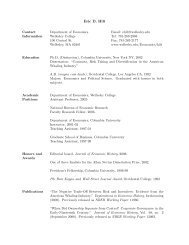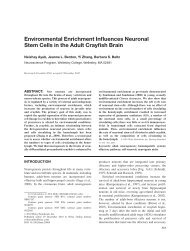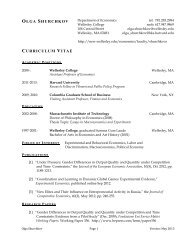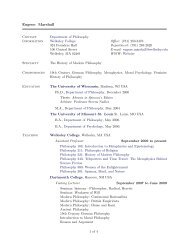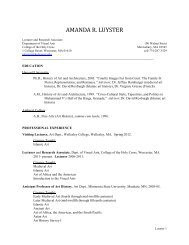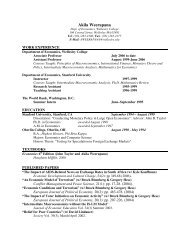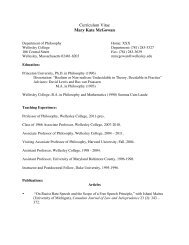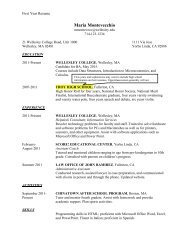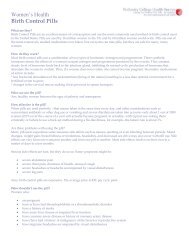Complete Conference Program - Wellesley College
Complete Conference Program - Wellesley College
Complete Conference Program - Wellesley College
Create successful ePaper yourself
Turn your PDF publications into a flip-book with our unique Google optimized e-Paper software.
3–4:10pm<br />
Reflections on the Afterlife: fra<br />
Girolamo Savonarola's Perspective<br />
on the eventuality of Death through<br />
Woodcut Illustrations<br />
Isabelle R. Erb ’13, Art History and Italian Studies<br />
AdvisoR: Jacqueline Musacchio, Art<br />
My Art History thesis focuses on Dominican<br />
friar Fra Girolamo Savonarola (1452-<br />
1498) and his role in popular religion in<br />
Renaissance Florence. He delivered sermons<br />
at San Marco, San Lorenzo, and the cathedral<br />
of Santa Maria del Fiore, to audiences<br />
of as many as 20,000. His preaching took<br />
advantage of contemporary crises, such as<br />
plague and famine, and achieved notoriety<br />
through his prophesies of spiritual renewal<br />
for the entire church. Savonarola’s sermons<br />
were circulated in the form of early printed<br />
books with woodcut illustrations. The woodcuts<br />
expressed his awareness of death as a<br />
lurking evil, ready to attack at the first sign<br />
of weakness; Savonarola told his followers<br />
to keep these woodcuts in their homes as a<br />
reminder of the inevitability of one’s passing.<br />
Ultimately, they proved to be a crucial aspect<br />
of Savonarola’s control over Florence.<br />
The fiction of the fabricated Ruin:<br />
exploring memory in the work of Adrián<br />
Villar Rojas<br />
Mina Juhn ’13, Art History<br />
AdvisoR: Patricia Berman, Art<br />
The sculptural practice of Adrián Villar Rojas<br />
(b. Argentina, 1980) threatens to fissure the<br />
continuous façade of our reality through its<br />
uncanny insinuation of parallel temporalities.<br />
His construction of monumental ruins<br />
amalgamates disparate forms ranging from the<br />
organic to the aggressively industrial, and his<br />
large-scale works are rendered more enigmatic<br />
due to their eventual destruction. His use of<br />
unfired clay produces a decaying aesthetic that<br />
alludes to the fragility of narratives traditionally<br />
imbued within monumental forms, thereby<br />
calling attention to the tenuous existence of<br />
individual and collective memory. Through an<br />
analysis of the artist’s monumental clay works,<br />
this thesis will examine how Villar Rojas’ ruinous<br />
aesthetic elucidates the calculated process<br />
of construing memory and history.<br />
The Search for Liberty in<br />
Captivity: Cervantes in Africa<br />
(panel discussion) Science Center 104<br />
Cara M. Borelli ’15, English, Melissa M.<br />
D'Andrea ’14, Biological Chemistry, Molly E.<br />
McNamara ’15, Spanish and Neuroscience,<br />
Rebecca J. Rubinstein ’15, Spanish, Gabriela<br />
M. Salcedo ’15, Undeclared, Anne V. West<br />
’15, Undeclared, Anne M. Williams ’13,<br />
Mathematics and Spanish<br />
AdvisoR: Jill Syverson-Stork, Spanish<br />
After fighting against the Ottoman Turks in<br />
the Battle of Lepanto in 1571, Miguel de<br />
Cervantes Saavedra was enslaved by his foes in<br />
Algiers (1575-1580). While held for ransom in<br />
this North African city, Cervantes witnessed a<br />
world diametrically opposed to his native Spain.<br />
Here, in Algiers’ multicultural, multilingual,<br />
and multi-faith society, Cervantes experienced<br />
captivity, yet also an ironic reprieve from the<br />
Spanish atmosphere of Inquisitorial suspicion.<br />
As goods, persons, and ideas were traded<br />
furiously around him, Cervantes calibrated and<br />
considered the values of empire. From salvation<br />
by faith, to gender roles, to the notion of free<br />
will, Cervantes left no absolute unscrutinized<br />
in his works. Over four hundred years later, the<br />
author’s illusive, engaging voice continues to<br />
challenge readers. After a semester of studying<br />
Cervantes, we hope to present a richer portrait<br />
of this former captive, beyond his well-known<br />
role as author of Don Quixote.<br />
The Unending Beauty of<br />
Schubert’s Lieder: A Lecture<br />
Recital on Word Painting<br />
(short performance) Jewett Arts<br />
Center-Auditorium<br />
Katherine A. Siegel ’14, Music<br />
AdvisoR: Jenny Tang, Music<br />
Whither, whither should you come to<br />
immerse yourself in the unending beauty of<br />
Schubert’s lieder? Schubert’s exquisite mastery<br />
of the lied (or German art song) will<br />
be our topic as you enjoy 3 of his over 600<br />
lieder. Ganymed (Goethe, 1817), An die<br />
Leier (Bruchmann, 1822) and Die Liebe Hat<br />
Gelogen (Platen-Hallermünde, 1822) are the<br />
poetic masterpieces that will be performed<br />
and discussed to demonstrate Schubert’s<br />
unparalleled ability to set the visions of poets<br />
to music. Schubert revolutionized the composition<br />
of song through his use of the piano<br />
and voice as equals in expressing the text.<br />
With the expressive power of the voice’s melody<br />
line and the piano’s harmony combined,<br />
Schubert achieved a level of “word painting”<br />
that will lead us on a journey through these<br />
poems about love, war and Greek Mythology.<br />
Mozart Sonata for Two Pianos<br />
in D major (K. 448)<br />
(short performance) Jewett Arts<br />
Center-Auditiorium<br />
Chuyan Huang ’15, Undeclared, Anita Z.<br />
Li ’15, Undeclared<br />
AdvisoR: Lois Shapiro, Music<br />
Wolfgang Amadeus Mozart has been celebrated<br />
as one of the most brilliant and<br />
prolific classical period composers. The D<br />
major sonata was composed in 1781 when<br />
Mozart was 25. It is among the few of his<br />
two piano pieces, but is very well-known for<br />
its “Mozart effect”, suggesting that classical<br />
music has a bigger chance of increasing reasoning<br />
skills and human brain activities than<br />
other types of music. The first movement<br />
Allegro con spirito starts off the sonata in D<br />
major, setting the central theme with a strong<br />
introduction. The second movement Andante<br />
is written strictly in an ABA structure at an<br />
appeasing tempo. The last movement Molto<br />
allegro has a reoccurring theme with highlycontrasting<br />
melodies. Through a semester<br />
of work under the guidance of instructors<br />
Randall Hodgkinson and Lois Shapiro, the<br />
presenters will perform the first two movements<br />
of the sonata.<br />
Science and Technology<br />
Garbage In, Garbage Out:<br />
Wall Street, Main Street, and<br />
i-Street<br />
(short talks) Science Center 278<br />
Technology and Wall Street<br />
Akofa A. Ahiable ’13, Computer Science<br />
AdvisoR: Brian Tjaden, Computer Science<br />
When Wall Street started, every transaction,<br />
every computation was done by hand.<br />
Exchange floors were constantly buzzing with<br />
human activity and interaction. However,<br />
with the advent of new technology, there was<br />
a massive change on the Street; floors were<br />
closed down and replaced with screen trading<br />
systems. David Leinweber in his book, Nerds<br />
on Wall Street said, “there’s so much technology<br />
in modern markets that it’s easy to forget<br />
that some of our favorite markets, like the<br />
New York Stock Exchange, started out as<br />
very low-tech places.” We’re going to take a<br />
journey through time to see how technology<br />
WELLESLEY COLLEGE RUHLMAN CONFERENCE 2013 41



